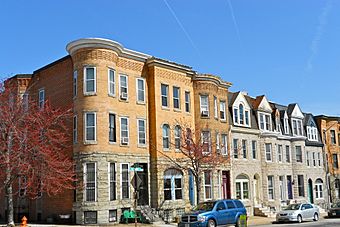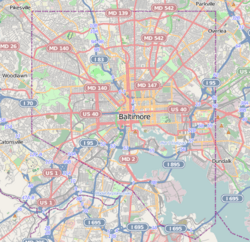Highlandtown, Baltimore facts for kids
Quick facts for kids |
|
|
Patterson Park-Highlandtown Historic District
|
|

Northeast corner of Baltimore Street and Luzerne Avenue
|
|
| Location | Roughly bounded by Patterson Park Ave., E. Fayette St., and Pulaski Hwy, Grundy St., Eastern Ave., Patterson Park, Baltimore, Maryland |
|---|---|
| Area | 295 acres (119 ha) |
| Built | 1867 |
| Architect | Gallagher, Edward J.; et al. |
| Architectural style | Late Victorian, Late 19th And 20th Century Revivals |
| NRHP reference No. | 02001623 |
| Added to NRHP | December 27, 2002 |
Highlandtown is a lively neighborhood in Baltimore, Maryland, United States. It's known for its rich history and diverse community. This area is a great example of a traditional working-class neighborhood that has changed over time.
Contents
Discover Highlandtown's Past
Highlandtown started as a small village called "Snake Hill" in 1866. It was located just outside the main city of Baltimore. The first people to settle here were mostly German Americans. In 1870, the residents decided to give their village a new name. They called it "Highland Town" because it offered amazing views over the city. The neighborhood officially became part of Baltimore City in 1919.
A Look at Its Location
Today, Highlandtown has clear boundaries. To the east, you'll find Haven Street. Baltimore Street is to the north, and Linwood Avenue is to the west. To the south, it's bordered by Eastern Avenue. Eastern Avenue is a very important street in Highlandtown. It's the main place for shops and businesses. A former mayor even called it a "Main Street District" to help boost local businesses.
A Working-Class History
Highlandtown has always been a neighborhood where many people worked in factories and industries. Because of this, it was recognized as part of the Patterson Park/Highlandtown Historic District. This district is listed on the National Register of Historic Places. If you live in Baltimore, you might hear people say "Hollantown" instead of Highlandtown!
For a long time, Highlandtown was a major center for commerce and industry. However, starting in the 1970s, things began to change. Many factories closed, and large department stores were replaced by shopping malls. This led to a period where the neighborhood faced some challenges.
Appalachian Roots
Highlandtown was also once known as "Little Appalachia." Before, during, and after World War II, many people from the Appalachian mountains moved to Baltimore. They came to places like Highlandtown looking for work and new opportunities.
Highlandtown Today
Highlandtown is a neighborhood that is always changing. While it still has strong roots from its early German, Polish, Czech, Italian, Irish, Greek, and Ukrainian settlers, it also has a growing Latino community.
You can also find the main office of the Baltimore Science Fiction Society on the northern edge of Highlandtown. This is a place where fans of science fiction can gather and share their interests.
Famous Faces from Highlandtown
Did you know that a very important person grew up in Highlandtown? Former United States Senator Barbara Mikulski spent her childhood here. She went on to have a long and successful career in politics.
Unique Street Names
If you look at the eastern part of Highlandtown, you'll notice something interesting about the streets. Eight blocks of streets run north and south, and their names start with consecutive letters of the alphabet. These are Baylis, Conkling, Dean, Eaton, Fagley, Grundy, and Haven. This pattern continues into the nearby Greektown neighborhood.
Who Lives in Highlandtown?
According to the census from 2010, about 7,820 people lived in Highlandtown. The neighborhood is very diverse. About 42.3% of residents were white, 34% were Hispanic, and 19.7% were African American. The remaining 5% included people from Asian and Native American backgrounds.
A Diverse Community
The Hispanic population in Highlandtown is made up of many different groups. These include people from Mexico, Puerto Rico, El Salvador, the Dominican Republic, Honduras, Nicaragua, Cuba, and Colombia, among others.
Most homes in Highlandtown are owned by the people who live in them. About 59.8% of the homes were owner-occupied in 2010.


